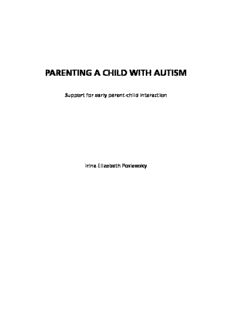
parenting a child with autism PDF
Preview parenting a child with autism
PARENTING A CHILD WITH AUTISM Support for early parent-child interaction Irina Elizabeth Poslawsky ISBN: 978-90-784-7724-2 Cover design & lay-out: Narratio, Gorinchem Cover illustration: Lieve Wis, 7 jaar Published by: Docete, Utrecht © 2013 I.E. Poslawsky No part of this thesis may be reproduced without prior permission of the author. PARENTING A CHILD WITH AUTISM Support for early parent-child interaction Het opvoeden van kinderen met autisme Ondersteuning van de vroege ouder-kind interactie (met een samenvatting in het Nederlands) Proefschrift ter verkrijging van de graad van doctor aan de Universiteit Utrecht op gezag van de rector magnificus, prof. dr. G.J. van der Zwaan, ingevolge het besluit van het college voor promoties in het openbaar te verdedigen op donderdag 9 januari 2014 des ochtends te 10.30 uur door Irina Elizabeth Poslawsky geboren op 27 januari 1954 te Utrecht Promotoren: Prof. dr. H. van Engeland Prof. dr. M.J. Bakermans-Kranenburg Copromotor: Dr. F.B.A. Naber Voor Marti Argeloos samen opgegroeid Contents Chapter 1 9 Introduction Chapter 2 27 Parental reaction to early diagnosis of their children’s Autism Spectrum Disorder: an exploratory study Chapter 3 61 Development of a Video feedback Intervention to promote Positive Parenting for Children with Autism (VIPP-AUTI) Chapter 4 81 Enhancing Parental Efficacy and Sensitivity to Children with Autism Spectrum Disorder: a Randomized Controlled Trial with Video-feedback to Promote Positive Parenting Adapted to Autism (VIPP-AUTI) Chapter 5 105 Improving Joint Attention of Children with Autism Spectrum Disorder: a Randomized Controlled Trial of a Parent-Mediated Intervention Chapter 6 127 Oxytocin enhances paternal sensitivity to a child with autism: A double blind within subject experiment with intranasally administered oxytocin. Chapter 7 141 Summary and General discussion Chapter 8 157 Nederlandse samenvatting Dankwoord Curriculum Vitae Publications 7 8 Chapter 1 Introduction 9 CHAPTER 1 Introduction “Because I am getting tired of people making remarks like “it’ll be OK”; “Just be stricter with him” and “It’s just fashionable to put a label on a child”. It’ll be OK: Well, no. Neil really does have autism, even though he is nothing like a drooling, contact-disturbed Rain Man. He has most trouble dealing with busy and noisy activities, people he doesn’t know, unexpected situations, loud noises, food; and regarding his language skills, he is “slow in understanding things”. He takes everything so literally. For example, when the doorbell rings and I ask him to open the door, he will do that, but then he will walk straight back, leaving the person standing by the door. He was asked to open the door, right? He also puts things together wrongly. A few months ago, he hit his head during gym class and he is now scared to hit his head again during gym class because gym class equals hitting his head. If something doesn’t goes as planned, or the furniture is rearranged, or we are in a busy or noisy place, it confuses him and a tantrum results. And there are about 83 other things that Neil has difficulties with. So, no, it’s not OK. Just be stricter with him: That won’t help. If Neil doesn’t want something, most of the time it’s because he doesn’t understand or because (he thinks) he won’t be able to manage. Getting angry will make it worse and then there will be another huge tantrum (again). It’s just fashionable to put a label on a child: It might look like that because we are learning more and more about autism. I am overjoyed with his label. Now I (and school and others) can help him and understand him better. If there had been no such diagnosis, he would probably be ‘that difficult and annoying child’. Now we can do something about it, or at least we can understand his situation better. Didn’t we all know a kid in school who didn’t fit in with the rest when we were little? Well, that kid is my kid…. By the way: my child is the sweetest child in the world! 10
Description: